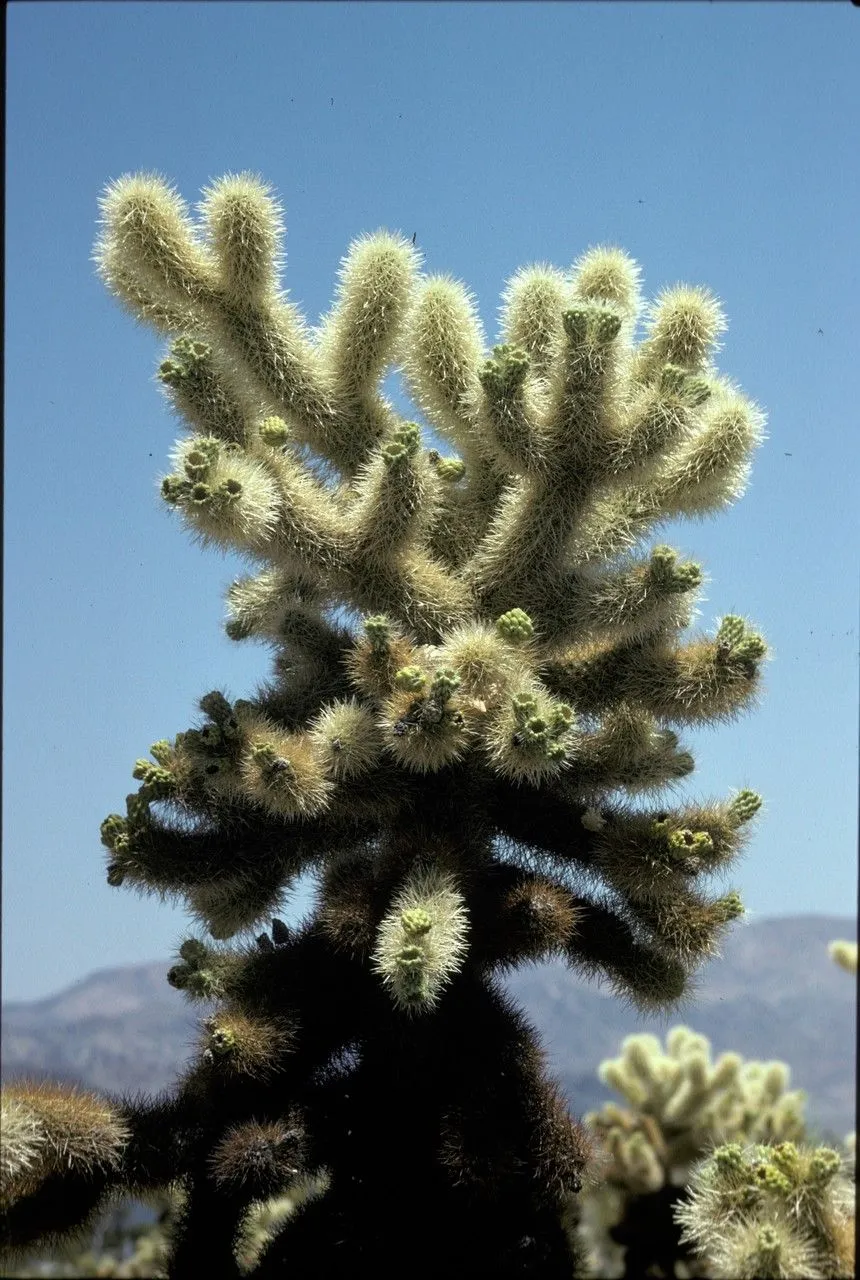
Author: (Engelm.) F.M.Knuth
Bibliography: Nye kaktusbog: 131 (1930)
Year: 1930
Status: accepted
Rank: species
Genus: Cylindropuntia
Vegetable: False
Observations: S. Nevada to New Mexico and NW. Mexico
The Teddy-bear cholla, scientifically known as Cylindropuntia bigelovii, is a captivating cactus species belonging to the Cactaceae family. Commonly referred to as the Teddy-bear cholla due to its deceptively cuddly appearance, this plant is native to a vast range extending from Southern Nevada through New Mexico and northwest Mexico.
The Teddy-bear cholla is an intriguing specimen within its native habitats. It thrives in arid desert climates, often forming dense stands that are a notable feature of the landscape. Characterized by its dense, spiny structure, the Teddy-bear cholla’s joints are covered in a whitish or yellowish sheath, giving it a somewhat furry, teddy-bear-like look. Despite its inviting appearance, the cactus is covered with spiky barbed spines that can easily detach and cling to passersby, an adaptation that aids in its propagation.
The plant typically grows to a height of 1 to 5 feet, with cylindrical joints that can break off and root to form new plants, ensuring the species’ spread. The cholla’s flowers, which bloom in the warmer months, are a delicate shade of greenish-yellow, further enhancing its unique appearance.
In the wild, the Teddy-bear cholla plays a crucial role in its ecosystem. It provides shelter and food for a variety of desert wildlife. Birds, in particular, are known to nest within its thorny branches, safely out of reach of many predators.
The study and classification of this cactus were officially recorded in the early 20th century, particularly noted in the work “Nye kaktusbog” published in 1930, under the authoritative guidance of (Engelm.) F.M.Knuth.
In summary, the Teddy-bear cholla (Cylindropuntia bigelovii) is a fascinating and vital part of the desert biome stretching from Southern Nevada to Northwest Mexico. Its unique appearance and ecological significance make it a plant of interest for botanists, ecologists, and desert enthusiasts alike.
En: Teddy-bear Cholla
: Teddybear cholla
Taken Jul 1, 1992 by Daniel Barthelemy (cc-by-nc)
Taken Jul 1, 1992 by Daniel Barthelemy (cc-by-nc)
Taken Jul 1, 1992 by Daniel Barthelemy (cc-by-nc)
Taken Jul 1, 1992 by Daniel Barthelemy (cc-by-nc)
Taken Jul 1, 1992 by Daniel Barthelemy (cc-by-nc)
Taken Jul 1, 1992 by Daniel Barthelemy (cc-by-nc)
Taken Jul 17, 1992 by Daniel Barthelemy (cc-by-nc)
Taken Jul 1, 1992 by Daniel Barthelemy (cc-by-nc)
Taken Jul 1, 1992 by Daniel Barthelemy (cc-by-nc)
Taken Jan 15, 2022 by x orkinson (cc-by-sa)
Taken Jul 17, 1992 by Daniel Barthelemy (cc-by-nc)
Taken Jul 1, 1992 by Daniel Barthelemy (cc-by-nc)
Taken Mar 20, 2022 by Martin Bishop (cc-by-sa)
Taken Oct 10, 2022 by plant gal (cc-by-sa)
Taken Sep 30, 2022 by Oğuzhan (cc-by-sa)
Taken Feb 24, 2022 by f emilia (cc-by-sa)
Taken Feb 21, 2020 by Beate Klösgen (cc-by-sa)
© copyright of the Board of Trustees of the Royal Botanic Gardens, Kew.
© copyright of the Board of Trustees of the Royal Botanic Gardens, Kew.
Growth habit>: Shrub, Subshrub
Family: Myrtaceae Author: (F.Muell.) K.D.Hill & L.A.S.Johnson Bibliography: Telopea 6: 402 (1995) Year: 1995 Status:…
Family: Rubiaceae Author: Pierre ex A.Froehner Bibliography: Notizbl. Bot. Gart. Berlin-Dahlem 1: 237 (1897) Year:…
Family: Sapindaceae Author: Koidz. Bibliography: J. Coll. Sci. Imp. Univ. Tokyo 32(1): 38 (1911) Year:…
Family: Asteraceae Author: A.Gray Bibliography: Pacif. Railr. Rep.: 107 (1857) Year: 1857 Status: accepted Rank:…
Family: Fabaceae Author: Medik. Bibliography: Vorles. Churpfälz. Phys.-Ökon. Ges. 2: 398 (1787) Year: 1787 Status:…
Family: Aspleniaceae Author: (Cav.) Alston Bibliography: Bull. Misc. Inform. Kew 1932: 309 (1932) Year: 1932…